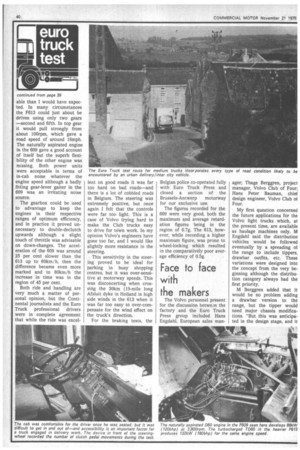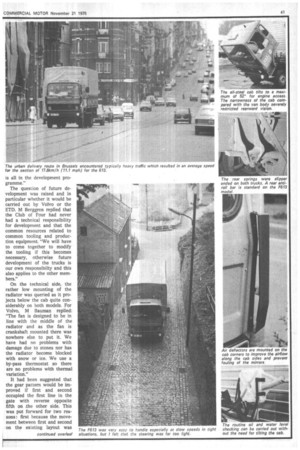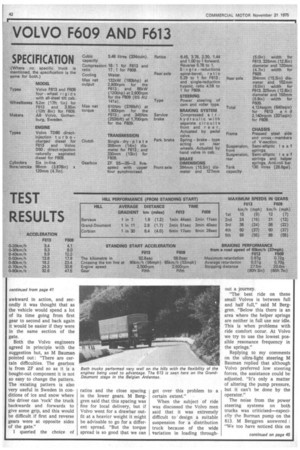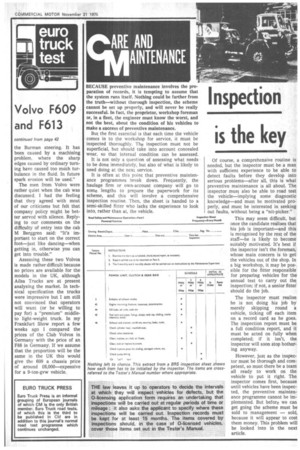Face to face with the makers
Page 46

Page 47

Page 48

Page 51

If you've noticed an error in this article please click here to report it so we can fix it.
The Volvo personnel present for the discussion betwem the factory and the Euro Truck Press group included Hans Engdahl, European sales man ager; Thage Berggren, project manager, Volvo Club of Four; Hans Peter Bauman, chief design engineer, Volvo Club of Four.
My first question concerned the future applications for the Volvo light trucks which, at the present time, are available as haulage machines only. NJ Engdahl said the distribution vehicles would be followed eventually by a spreading of the range to include tippers, drawbar outfits, etc. These variations were designed into the concept from the very beginning although the distribution category always had the first priority.
M Berggren added that it would be no problem adding a drawbar version to the range, but the tipper would need major chassis modifications. "But this was anticipated in the design stage, and it is all in the development programme."
The question of future development was raised and in particular whether it would be carried out by Volvo or the ETD. M Berggren replied that the Club of Four had never had a technical responsibility for development and that the common resources related to common tooling and production equipment. "We will have to come together to modify the tooling if this becomes necessary, otherwise future development of the trucks is our own responsibilty and this also applies to the other members."
On the technical side, the rather low mounting of the radiator was queried as it projects below the cab quite considerably on both models. For Volvo, M Bauman replied: "The fan is designed to be in line with the middle of the radiator and as the fan is crankshaft mounted there was nowhere else to put it. We have had no problems with damage due to stones nor has the radiator become blocked with snow or ice. We use a by-pass thermostat so there are no problems with thermal variation."
It had been suggested that the gear pattern would be improved if first and second occupied the first line in the gate with reverse apposite fifth on the other side. This was put forward for two reasons: first because the movement between first and second on the existing layout was awkward in action, and secondly it was thought that as the vehicle would spend a lot of its time going from first gear to second and back again it would be easier if they were in the same section of the gate.
Both the Volvo engineers agreed in principle with the suggestion but, as M Bauman pointed out : "There are certain difficulties. The gearbox is from ZF and so as it is a bought-out component it is not so easy to change the pattern. The existing pattern is also very useful in Sweden in conditions of ice and snow where the driver can 'rock' the truck backwards and forwards to give some grip, and this would be difficult if first and reverse gears were at opposite sides of the gate."
I queried the choice of ratios and the close spacing in the lower gears. M Berggren said that this spacing was fine for local delivery, but if Volvo went for a drawbar outfit at a heavicr weight it might be advisable to go for a different spread. "But the torque spread is so good that we can get over this problem to a certain extent."
When the subject of ride was discussed the Volvo men said that it was extremely difficult to design a suitable suspension for a distribution truck because of the wide Variation in loading through out a journey.
"The best ride on these small Volvos is between full and half full," said M Berggren. "Below this there is an area where the helper springs are neither in full use nor idle. This is when problems with ride comfort occur. At Volvo we try to use the lowest possible resonance frequency in the springs."
Replying to my comments on the ultra-light steering M Bauman replied that although Volvo preferred low steering forces, the assistance could be adjusted. "It's only a matter of altering the pump pressure, but it can't be done by the operator."
The noise from the power steering systems on both trucks was criticised-especially the Burman pump on the 613. M Berggren answered : "We too have noticed this on the Burman steering. It has been caused by a machining problem, where the sharp edges caused by ordinary turning have caused too much turbulance in the fluid. In future spark erosion will be used."
The men from Volvo were rather quiet when the cab was discussed. I had the feeling that they agreed with most of our criticisms but felt that company policy might be better served with silence. Replying to our comments on the difficulty of entry into the cab M Berggren said "It's important to start on the correct foot—just like dancing—when getting in, otherwise you can get into trouble."
Assessing these two Volvos is made rather difficult because no prices are available for the models in the UK, although Ailsa Trucks are at present analysing the market. In technical specification the trucks were impressive but I am still not convinced that operators will want (or be willing to pay for) a "premium" middleto light-weight truck. In my Frankfurt Show report a few weeks ago I compared the prices of the Club Volvos in Germany with the price of an F88 in Germany. If we assume that the proportion will be the same in the UK this would give the 609 a chassis price of around £6,000—expensive for a 9-ton-gvw vehicle.








































































































